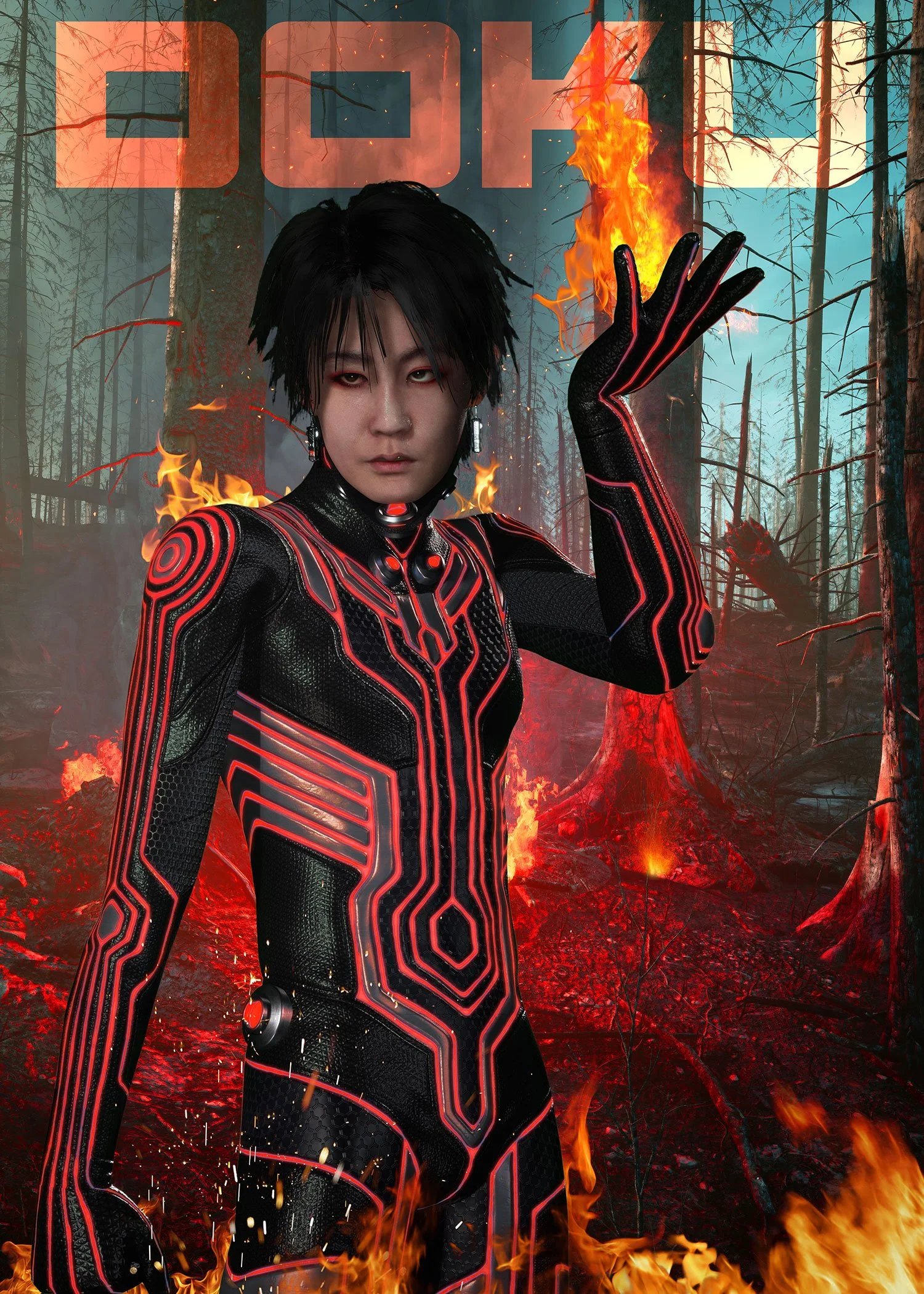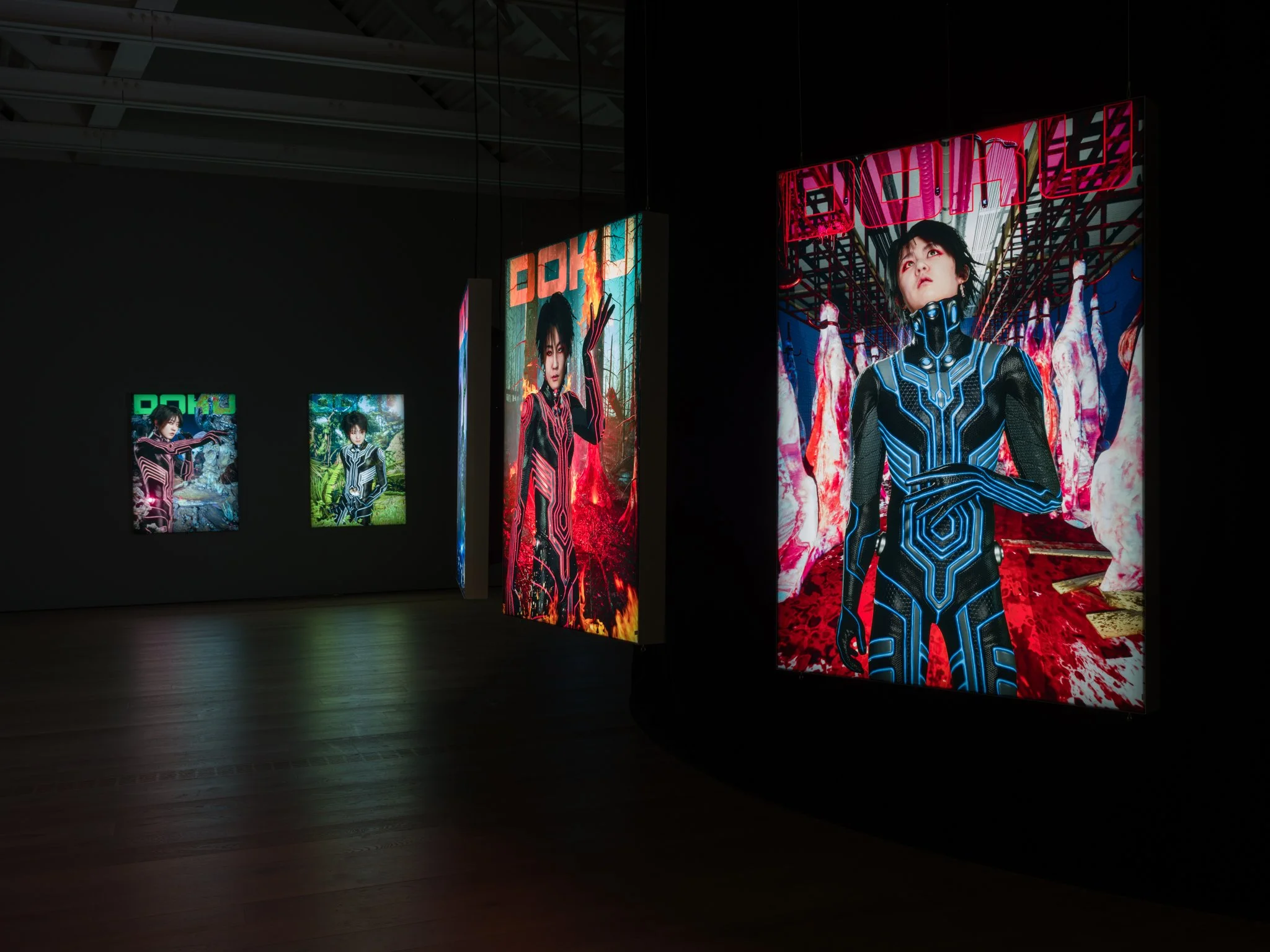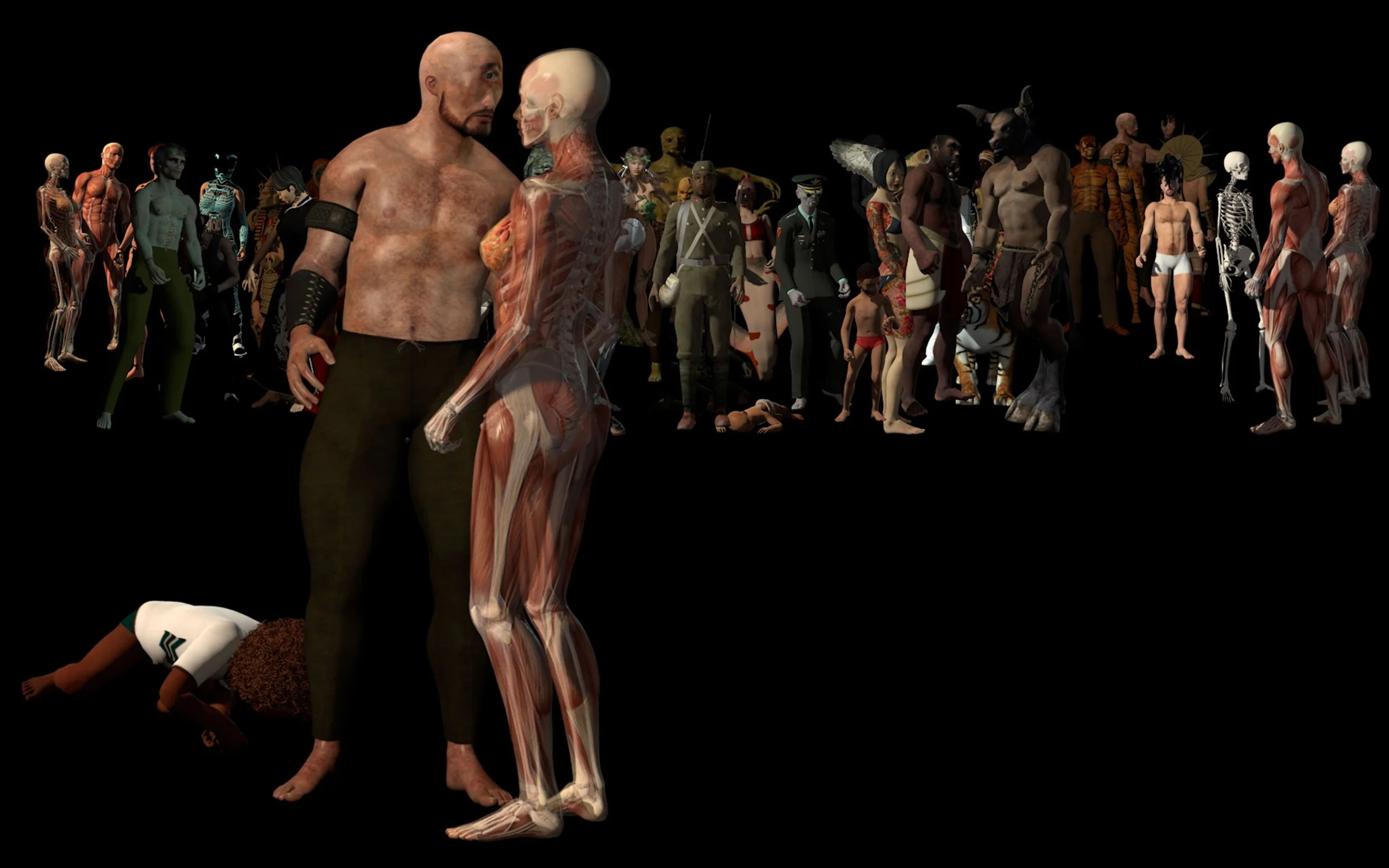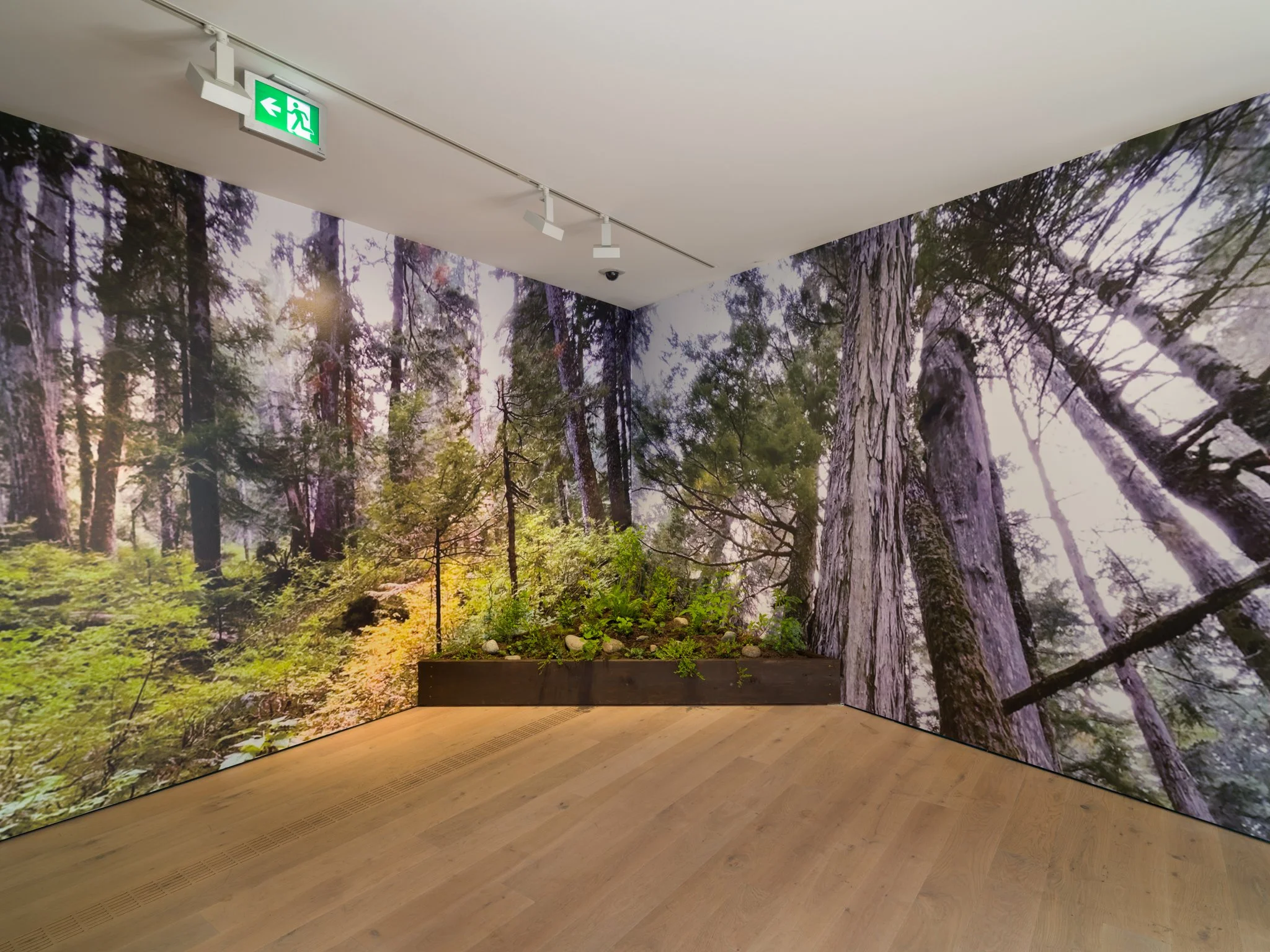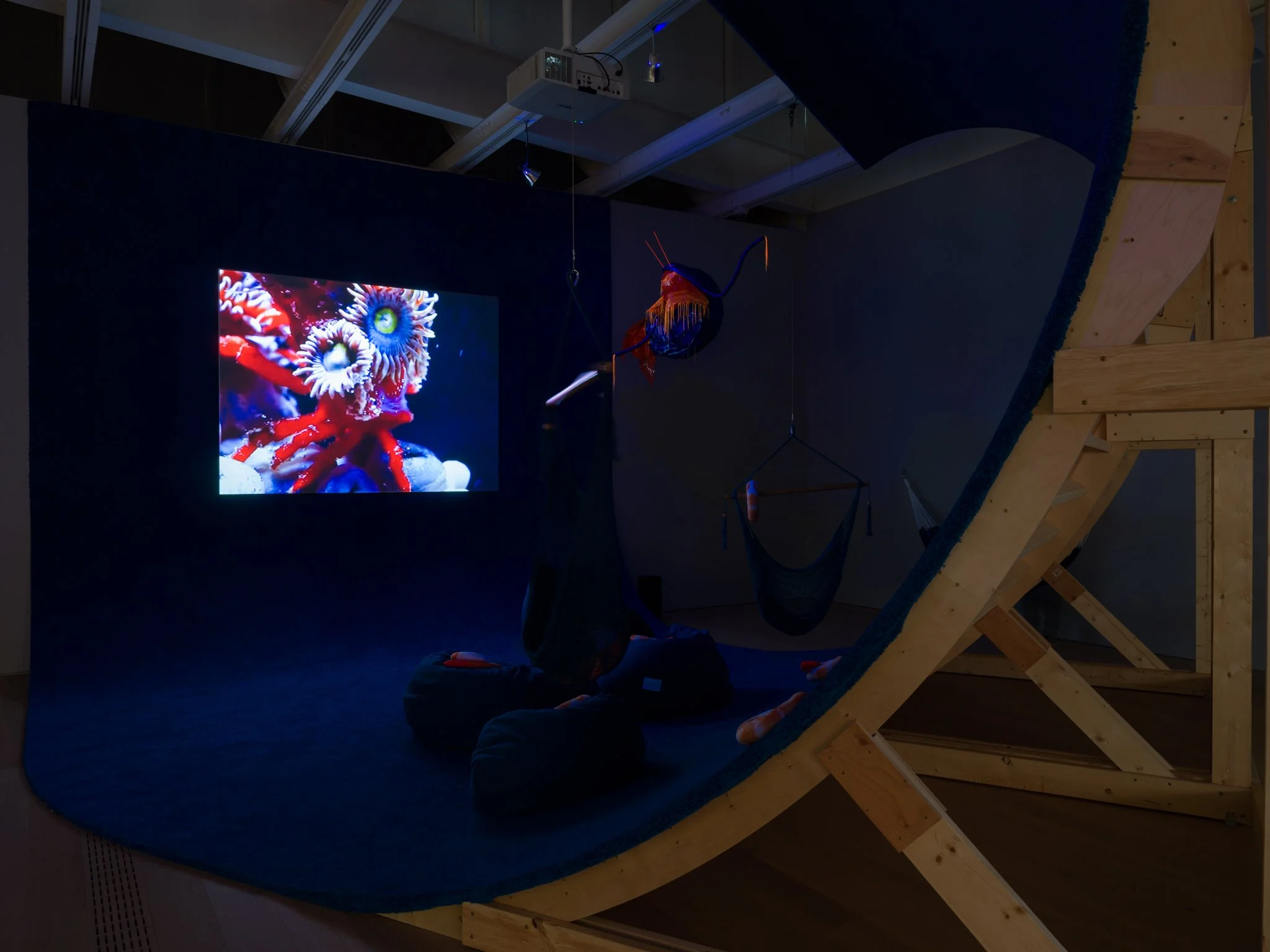Slipping between the real and virtual, the human and nonhuman at The Polygon Gallery's new Ghosts of the Machine exhibit
Nonbinary avatars meet live gardens with augmented-reality fauna, as the digital and natural merge
Lu Yang, Hell Realm #1, 2021, Aluminum, LED Lights, Backlit Fabric
Installation view of Lu Yang’s “Doku: Digital Alaya” series. Photo by Dennis Ha
The Polygon Gallery presents Ghosts of the Machine to August 14
A NONBINARY DIGITAL avatar wearing a sci-fi bodysuit stands amid a 3-D environment that is all too realistic and familiar: a forest fire. Flames lick up from their hand, engulfing skeletal trees in the background. In another image, the same cyborg-like character, named Doku, passes through bombed-out buildings that look ripped right out of the war in Ukraine.
They’re two glowing, backlit pieces from Shanghai artist Lu Yang’s “Doku: Digital Alaya” series, each representing the six realms of Buddhism. In the images, the virtual slips into the very real crisis on Earth today—an ongoing emergency that the artist seems to suggest arises from a dependence on technology. Its constant bombardment distracts us from spiritual unity with the planet that we live on.
It’s no surprise that Heaven Realm #1 depicts Doku stepping through a lush, tropical landscape.
“Slips” and “slippage” are words that come up again and again in a tour of the thought-provoking new exhibit Ghosts of the Machine at The Polygon Gallery. The work moves fluidly between the human and nonhuman, the digital and the natural. Boundaries between genders and realities blur.
As curator Elliott Ramsey puts it: “All these binaries cease to exist and we slip through them almost as easily as a ghost slips through walls.”
The curator, who put together last year’s gender-fluid Interior Infinite exhibit at the Polygon, said the new show arose in part from a strong interest in video-game avatars as a queer kid growing up, and the way they offered possibilities beyond the binary constraints of the “real” world. Connecting the dots for this show, Ramsey started noticing works that linked the metaverse to concerns for our environmental collapse. Instead of providing simple escape, the digitally generated world was speaking directly to real-world concerns.
“I had been really interested in this overlapping of queer avatars and this expansiveness that the artists were using to really talk about ecology,” Ramsey explained to Stir at the gallery. “I was interested in where and how these avatars show up—not necessarily in the virtual world but the physical world. So it really started out with this weird triangulation of queerness, the avatar, and the environment.”
One of the standout pieces in the show is Singapore artist Ho Tzu Nyen’s No Man II, an eerie single-channel projection on a police-interrogation-style one-way mirror. It features a rotating array of digitally generated figures drawn from mythological, medical, video-game, and pop-cultural realms—cyborgs, minotaurs, zombies, anatomical figures, skeletons, and bikini’d body builders. Their mouths move as they sing a ghostly chorus of John Dunne’s Devotions Upon Emergent Occasions (the “No Man Is an Island” poem, slightly altered to refer to Malaya). When viewers step into a spotlight, they are reflected amid the life-sized figures, whose chorus falls in and out of unison, phrases trailing off. It is a deeply haunting meditation on not only isolation (especially as it relates to Singapore’s city-state), but the kind of archetypes that connect us globally.
Ho Tzu Nyen’s No Man II, 2017. Courtesy of artist, Galerie Michael Janssen, Edouard Malingue Gallery
In New York-based artist, DJ, and author Juliana Huxtable’s ARI 2, a figure morphs from human to fetishized serpentine creature. The human-animal hybrid leans seductively on a photographed leopard-print chair, the body turning fluidly from digital-real to painting. While celebrating the way that anthropomorphized creatures can transcend limitations of identity, Huxtable’s works also probe the implications of industrial-agriculture and technological developments—and our drive to domesticate and exploit animals.
“She really embodies this slipperiness, with this mermaid-like form,” Ramsey observes. “She also slips from photography through painting to collage. That plurality really resonates with this exhibit.”
Nearby, viewers can settle into a beanbag chair on a wavelike blue-shag carpet to watch a big screen where starfish, shrimp, and other sea creatures spawn and reproduce in ways that challenge all-too-human notions of sex. In Berlin-based Anne Duk Hee Jordan’s Ziggy and the Starfish, there’s something erotically alluring about the undulating anemone orifices and sensually waving tentacles, all set to an electro-rhythmic score of suggestive vocalizations, instrumentation, and watery burbling. Ramsey points out the underlying eco-message here, too: that climate change is causing unsettling shifts in undersea sex lives—disruptions and mutations in reproduction.
There is more—much more—to titillate and provoke, while breaking down binaries.
Installation view of Cease Wyss’s garden area as you exit the exhibit. Photo by Dennis Ha
Exiting the dark main hall, gallerygoers emerge into a sunlit atrium where artist-ethnobotanist Cease Wyss has installed a carefully tended garden of West Coast-native plants used for medicinal and nutritional purposes in Indigenous culture. Even here, the digital intervenes: visitors can use their phones for an augmented-reality experience by Syilx artist Tracey Kim Bonneau (who is part of Indigenous Matriarchs 4 [IM4] with Wyss). The interface sends a hummingbird or butterfly, drawn from Indigenous stories and culture, floating through the ferns and salal.
Where the avatar Doku walks through digitally re-created greenery in Heaven Realm #1, now virtual creatures inhabit real plants. As Ramsey puts it, “We can’t constrain reality into ‘real’ and ‘virtual'"—at least not anymore.
The viewing area for Anne Duk Hee Jordan’s Ziggy and the Starfish. Installation photo by Dennis Ha


